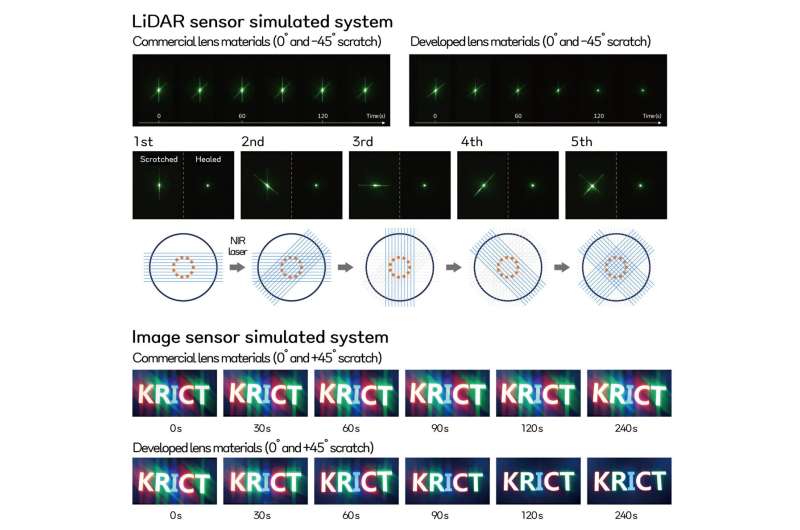Development of self-healing lens material to prevent traffic accidents in self-driving cars
Safety issues of self-driving cars have emerged due to frequent traffic accidents. A self-healing lens material that can prevent car accidents that occur due to signal distortion by healing scratches on the sensor surface of the self-driving car has been developed.
The Korea Research Institute of Chemical Technology (KRICT) research team led by Dr. Kim Jin Chul, Park Young Il, and Jeong Ji-Eun and Prof. Kim Hak-Rin and Prof. Cheong In Woo in Kyungpook National University (KNU) have developed a material that heals scratches on the sensors of autonomous vehicles. The work is published in the journal ACS Applied Materials & Interfaces.
When this self-healing optical material is used in the sensor of an autonomous vehicle, the life expectancy of the product can be increased, and future technology that can prevent malfunctions due to surface damage can be anticipated.
A lens is a tool that collects or disperses light and is used in many everyday optical devices such as cameras, cell phones, and glasses. However, if the lens surface is damaged by a scratch, the image or optical signal received by the optical device can be severely distorted.
Recently, traffic accidents caused by recognition errors and malfunctions in vision systems such as LiDAR sensors and image sensors of self-driving cars have repeatedly occurred. As a result, confidence in the safety of self-driving cars is rather low.
[embedded content]
The KRICT-KNU joint research team developed a transparent lens material that can remove scratches on the sensor surface within 60 seconds when sunlight is focused using a simple tool such as a magnifying glass.
Because self-healing is favorable when molecular movement within the polymer is free, flexible materials are generally provide excellent self-healing performance. However, lenses or protective coating materials are made of hard materials, and thus it is difficult to impart a self-healing function. To solve this problem, the research team combined a thiourethane structure, which is already being used as a lens material, and a transparent photothermal dye to design a “dynamic chemical bond” in which the polymers repeat disassembly and recombination under irradiated of sunlight.
In particular, the developed transparent organic photothermal dye can selectively absorb light of a specific near-infrared wavelength (850–1050 nm) without interfering with the visible light region (350–850 nm) used for image sensors and the near-infrared region (~1550 nm) used for LiDAR sensors.

When sunlight is absorbed by photothermal dyes, the surface temperature of the developed lens material rises as the light energy is converted into thermal energy. Subsequently, the increased surface temperature makes it possible to self-heal a surface scratch by repeating the dissociation and recombination of chemical bonds in the polythiourethane structure.
The developed lens material shows perfect self-healing even when scratches cross each other, and provides excellent resilience, maintaining 100% of the self-healing efficiency even if the process of scratching and healing at the same location is repeated more than five times.
Dr. Lee Young Kuk, president of KRICT, said, “This technology is a platform technology that synthesizes self-healing lens materials using both an inexpensive high-refractive polymer material and a photothermal dye. It is expected to be widely used in various applications such as autonomous vehicle sensors as well as glasses and cameras.”
More information:
Ji-Eun Jeong et al, NIR-Triggered High-Efficiency Self-Healable Protective Optical Coating for Vision Systems, ACS Applied Materials & Interfaces (2023). DOI: 10.1021/acsami.2c21058
Provided by
National Research Council of Science & Technology
Citation:
Development of self-healing lens material to prevent traffic accidents in self-driving cars (2023, May 22)
retrieved 23 May 2023
from https://techxplore.com/news/2023-05-self-healing-lens-material-traffic-accidents.html
This document is subject to copyright. Apart from any fair dealing for the purpose of private study or research, no
part may be reproduced without the written permission. The content is provided for information purposes only.

Comments are closed